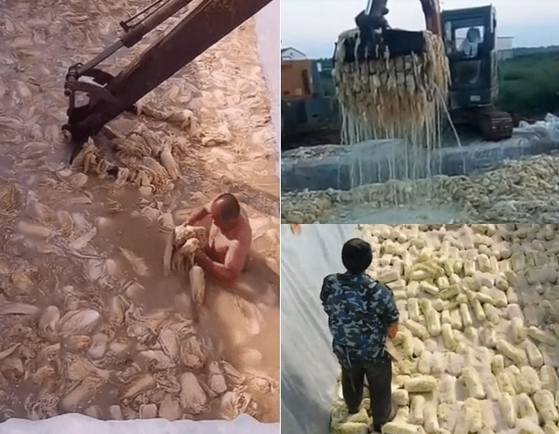
It was introduced to the online community at home and abroad, saying it was a video of the process of making kimchi in China. Photo online community
Mr. Kim Mo (39, Yongin-si, Gyeonggi-do), an office worker, said, “If you go to a restaurant that serves Chinese kimchi, you don’t eat kimchi at all.” He said, “I was shocked after seeing a video of a Chinese kimchi factory on YouTube.”
As a video known as a Chinese kimchi factory is released on online communities and social media, consumer anxiety about Chinese kimchi is growing. In this video, a naked worker enters a bucket of yellow water and stirs the cabbage with his bare hands. Another worker stepped on the radish in the pit. It is also seen that pickled cabbages are transferred to a rusty excavator. As this video spreads, more and more people avoid restaurants that use Chinese kimchi at all or are reluctant to eat kimchi-based restaurants such as kimchi stew and kimchi steamed food. As the controversy grew, the government came up with measures to strengthen the safety of pickled Chinese cabbage.
On the 17th, the Ministry of Food and Drug Safety said, “We will strengthen safety management from the local production stage to the customs clearance and distribution stage for pickled Chinese cabbage, which has become an issue.”
The Ministry of Food and Drug Safety explained that it is a precautionary measure that takes into account consumer concerns about the controversy over the unsanitary manufacturing environment of Chinese pickled cabbage.
The Ministry of Food and Drug Safety said, “At the customs clearance stage, only Chinese pickled cabbage and kimchi that meet domestic standards and standards are allowed to be imported, and since the 12th, we have been strengthening detailed inspections such as customs clearance, preservatives, and food poisoning bacteria. In addition to the standards and standards specified in the regulations, tests for food poisoning bacteria such as intestinal hemorrhagic E. coli are additionally conducted.” According to domestic standards and standards, kimchi is tested for lead, cadmium, tar color, preservative, coliform group, and pickled cabbage is tested for bacterial count, coliform group, E. coli, tar color, and preservative.
From the 22nd, the Ministry of Food and Drug Safety has announced a safety inspection for each stage of distribution (store warehouses, food marts, wholesale and retail companies, restaurants, etc.), focusing on raw materials such as kimchi, minced garlic, and red pepper powder imported with consumer organizations.
However, there is a limit to the crackdown on local production stages. The Ministry of Food and Drug Safety explained, “The Chinese side asked for thorough hygiene management of the workplace environment, manufacturing facilities, and handling of food products, etc. of businesses that export food to Korea, such as kimchi.”
Reporter Esther [email protected]
![]()
